Denis Larsen in Valladolid, Yucatan, Mexico: Changing Trajectories, Dispensas, and the Importance of Nail Polish
.JPG) Editor's note: Denis Larsen has consistently been kind, generous and helpful answering questions from our readers, so it was with great interest that we sat down with Denis April 5, 2017, to find out exactly what path he took to live in Mexico, and how it was working out. The result was unexpected, almost at every turn...]
Editor's note: Denis Larsen has consistently been kind, generous and helpful answering questions from our readers, so it was with great interest that we sat down with Denis April 5, 2017, to find out exactly what path he took to live in Mexico, and how it was working out. The result was unexpected, almost at every turn...] Chuck Bolotin: Denis, you’ve led a very, very interesting life in a lot of locations. From what I know, in the US, you’ve lived in North Dakota, Montana, Illinois, New York, Pennsylvania, New Hampshire and New Jersey, and you’ve also lived in Spain and in several different parts of Mexico. Now, you live in the town of Valladolid in the Mexican State of Yucatan, in the Yucatan Peninsula. Do I have that right so far?
Denis Larsen: Yes; that’s right.
CB: Please give us the theme that ties all these together.
Denis Larsen: I don’t know if there is a theme. In my early years, my parents moved and I moved with them. My dad went back to school when he was about 38 to get his Bachelor of Science in Bozeman, Montana and then he got a fellowship at the University of Illinois to get his master’s degree in soil mechanics; he was a civil engineer.

My dad got two job offers right away. One was to La Porte, Indiana and one was to Madrid, Spain. It took him about three and a half minutes to make the decision to choose Spain. So, at the age of 15 or so, in the middle of high school, was my first time out of the country, other than being to southern Canada. But it was the first time I felt I was really out of the country, and I loved it. It was really cool.
Unfortunately, I went to an American military high school so I didn’t learn as much Spanish as I should have in the two years I spent in Madrid. I spent a summer in Luzon, Switzerland, trying to learn French but I’m not a good language student so that didn’t get me very far, either.
CB: What was it like leaving Illinois in the middle of high school?
Denis Larsen: At high school in Illinois, I had been class president and the most valuable on the track team. It was my sophomore year. I had a really nice future ahead of me but it didn’t bother me at all to pick up and leave to go to Spain. I shouldn’t say it didn’t bother me. I’m sure I did have worries and concerns but nothing significant enough to stop me from going.
CB: So how do you think moving to Spain changed you? At the age of 15, you’re on a typical all-American trajectory and now you’re put into a completely foreign place. I assume you didn’t know Spanish.
Denis Larsen: I didn’t know Spanish and I didn’t know anybody in Madrid. I was walking into a completely new situation in just about every aspect. As just one example, I’d never eaten a piece of chicken before without using my fingers and when I got to Spain, you have to eat chicken with your knife and fork. At 15 that’s a challenge!
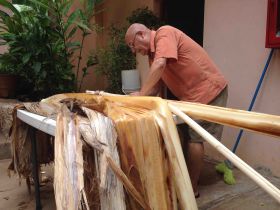 CB: What were the other kids in school like?
CB: What were the other kids in school like? Denis Larsen: Almost all the kids in the school were army brats or engineer brats. So many of them were used to picking up every two years and meeting new folks.
CB: How do you think that affected you? How did that change the trajectory of your life?
Denis Larsen: It made me more open to possibilities. I’ve made a number of decisions in my life that I look back and ask, “Was that the right thing to do?” but it was the thing I did. I turned down what could’ve been some very nice offers along the way.
CB: Please tell us about some of them.
Denis Larsen: I went to art school in New York. I had an offer to basically apprentice with one of my instructors, which I turned down. I worked in a dress house in Manhattan during the summer. When I said I was going back to school in fall, they said, “If you go to the Fashion Institute of Technology or Parsons for fashion, we’ll pay for your tuition, and we’ll guarantee you a job when you get out.” I told them, “No, I want to be an artist with a capital A.”
Other times in my life, I’ve had opportunity to either buy into a business or take over a business. That made me feel really good I got the offer, but it wasn’t where I wanted to go.
CB: So where did you want to go in those early days?
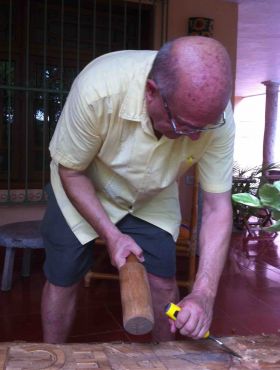
Denis Larsen: At first I thought I was going to be an engineer like my dad but that didn’t work out well because I just couldn’t understand differential equations. So I switched majors to Liberal Arts and Sciences. I took a Kuder Preference Test, which was a big deal at that time, which said I should be a writer or a photographer. So I went to New York to art school to become an artist. I took my courses there and realized just before graduating from the School of Visual Arts that I didn’t have the talent to be an artist with the capital A.
So I walked out of school and lived in the lower eastside of Manhattan at the time when it was a pretty rough neighborhood. I understand that now it’s gentrified. I was commuting from New Jersey to school, which was getting old, so I found a 5-room apartment in lower eastside for $50 a month. It was a six floor walk-up. That was a downside.
My mother sent all the things mothers would send—irons and toasters and whatever appliances she could think of. The first week I was there I got burgled and the only things taken were these new things my mother had sent.
Right afterward, I ran into a guy on East Fourth Street between C and D. I don’t know if you know Manhattan, but most people if they had a choice would not go there. He had dropped out of the School of Visual Arts also and became a Hell’s Angel down there. I just kind of casually mentioned to him that I got burgled. We were standing on a stoop of a brownstone when he put his arm around me and just generally addressed the street, not anybody in particular, “This is my friend. Don’t f--- with him.” I never had another problem.
CB: You meet a lot of colorful characters. Did you become a Hell’s Angel?
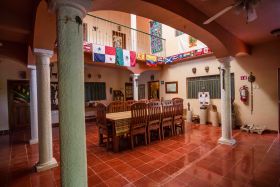 Denis Larsen: Oh no. A lot of my friends were bikers, but not me. I lived between New York City and Bucks County in Pennsylvania for, I guess, close to two years and finally decided that my life was going nowhere, so I went back to New Jersey and started working. I worked pumping gas and learned to be a mechanic at the same time and running a small engine repair business for someone else.
Denis Larsen: Oh no. A lot of my friends were bikers, but not me. I lived between New York City and Bucks County in Pennsylvania for, I guess, close to two years and finally decided that my life was going nowhere, so I went back to New Jersey and started working. I worked pumping gas and learned to be a mechanic at the same time and running a small engine repair business for someone else. And then I got into pre-stressed concrete as a laborer, but they found out I could read prints and plans, so I was put in charge of quality control for the big, big beams that they use for bridges and so many platforms in New York transit system.
While I was sitting in a drugstore waiting, I was reading a magazine about industrial design. I’d never even heard of the field before and I thought, “That sounds really interesting.” So I wound up at Parsons School of Design in Manhattan where I was a merit student of the year in the US. I was really good at what I did and I went to work for one of my instructors designing and drawing furniture. I thought that was going to be my trajectory.
Then I got a contract from General Foods to develop new food products for new beverages for youngsters that nobody knew how to do; it wasn’t a field. So that’s what I did for the next 20 or 30 years—conceptually develop new consumer products and services. I only did a few, what I would call, industrial design jobs in that period for clients. I helped design some of the Huggies from Kimberly-Clark. I think I gave Kimberly-Clark the whole idea of Depend for older people. It was nothing that was earth shattering, but it was a good life and I got to travel in the States.
 I lived right on the New York state border in New Jersey when we went to the garage sale at a fairly pricey town in southern New York state of a couple who were downsizing to move into Manhattan. The woman was selling a collection of Japanese woodblock prints. I had read a book about Japanese woodblock prints many years prior and these just looked right. So after consulting with our wives, my friend and I each put in $1,500 and we bought the whole collection for $3,000. We had no idea what we had.
I lived right on the New York state border in New Jersey when we went to the garage sale at a fairly pricey town in southern New York state of a couple who were downsizing to move into Manhattan. The woman was selling a collection of Japanese woodblock prints. I had read a book about Japanese woodblock prints many years prior and these just looked right. So after consulting with our wives, my friend and I each put in $1,500 and we bought the whole collection for $3,000. We had no idea what we had. So for the next couple of years I wrote a monthly newsletter called something like, “Japanese Woodblock Print Dealer and Collectors Newsletter”. Every month I had a centerfold of the anatomy of a woodblock print explained into various cartouches and signatures and little bit about the artist and the subject. I sold most of my subscriptions to museums and libraries. And then at the end of each year, I published a kind of a price guide handbook to Japanese woodblock prints. I was doing this all on an IBM Selectric; literally cut and paste.
Somewhere in there, I visited my cousin in Stillwater, Minnesota, who showed me a picture of him and 50 high school kids at the beach near Merida where he was running and doing volunteer trips.
He said, “Why don’t you come along?”
“Are you kidding me? To babysit 50 teenagers?”
It just sounded like something I would have no interest in at all. But the next year, a couple of friends from the church and I joined another group just to see what it was like. When I got there, I just fell in love with the climate, the people, the food, the everything. We were in a small fishing village northwest of Merida, Chuburna Puerto.
I went there for a week. The first year afterwards, I went there for two weeks. The second and third year, I got onto the board of trustees of the group and was going up to six times a year. I did a little bit of physical labor but mostly I was helping with logistics and buying and preparing food, because on some of the trips there would be 110 people traveling. The kitchen work was from 6 in the morning until 9 at night.
.jpg) Because I was coming so frequently, one point I said, “I’m coming back in a couple of weeks, so maybe I should just rent a place on Isla Mujeres and hang out for a couple of weeks and meet the next group that comes in.” So I did that.
Because I was coming so frequently, one point I said, “I’m coming back in a couple of weeks, so maybe I should just rent a place on Isla Mujeres and hang out for a couple of weeks and meet the next group that comes in.” So I did that. CB: Did you speak Spanish this whole time?
Denis Larsen: No, I still don’t speak Spanish; I muddled through Spanish. I now have a few words on my end. I can hold a conversation as long as I know what it’s about. If I walk in the middle of somebody else’s conversation, not necessarily.
Somewhere in there I actually retired so I didn’t have enough money to travel as much as I wanted. I did some traveling to South America and to Central America—Honduras, Guatemala, and Belize. I really enjoyed that. I did a 2-week volunteer stint on a Mayan dig in northern Belize.
Probably that same year I dislocated my foot on a motor scooter accident that was entirely my fault. I came around the curve too fast and because it was a new scooter to me I applied the accelerator rather than the brake and almost ran square into a telephone post without a helmet. I would’ve been dead if I hit it, but instead I stopped about two inches away from it. I put my feet out to stabilize myself on a slope and I and the bike just went over. I had come to a stop at that point, fortunately, but I dislocated my foot when I went over.
I was laying on my back in the middle of the street with a circle of about 30 people around me saying, “Well, it looks like he lost his foot.” I could see the sole of my foot but I couldn’t see the top of it. The ambulance came before the police came which is good because I didn’t have a license on the bike yet. They took me to the hospital, Centro de Salud, which at that time was just about the only game in town on Isla Mujeres. I knew the doctor who was running the ER that day who said, “Don’t even take him out of the ambulance. We can’t do anything for him here. Take him down by the dock. We’ll have a boat take him over to Cancun.”
 So I had a private boat take me over to Punta Sam, an ambulance met me and they took an x-ray. Then, they knocked me out for 3 seconds and put my foot back in position. I went back to the States for about a month doing physical therapy which just didn’t seem to be helping so I went back to Isla Mujeres and did yoga three days a week, massage a couple of days a week, and then walked down the beach on the sand.
So I had a private boat take me over to Punta Sam, an ambulance met me and they took an x-ray. Then, they knocked me out for 3 seconds and put my foot back in position. I went back to the States for about a month doing physical therapy which just didn’t seem to be helping so I went back to Isla Mujeres and did yoga three days a week, massage a couple of days a week, and then walked down the beach on the sand. All of that together with a little physical therapy really seemed to help. I decided it’s either I become a yoga instructor or a massage therapist.
I became a massage therapist around 2003 or early 2004 when one of my instructors said they’re accepting applications for massage therapists for the Olympics in Athens. I applied for the Paralympics which is usually two weeks or so after the Olympics at the same venue and got accepted. Out of a group of 48 there were almost 15 languages between us and we're still in touch, many of us, through Facebook.
After that I ran a pro bono clinic on Isla Mujeres for the locals. Once they figured out that they didn’t have to pay, they started bringing gifts. I would get shrimp, then octopus, and then people would bring me things like pears and apples. I thought bringing pears and apples was kind of weird until I realized that pears and apples here are exotic fruit. They didn’t grow here like mangoes and bananas.
When I started hearing English on Isla Mujeres too often I made a list of five cities that I had visited as a tourist, which were Mayan cities that then had a colonial overlay. They were Valladolid, Izamal, Merida, 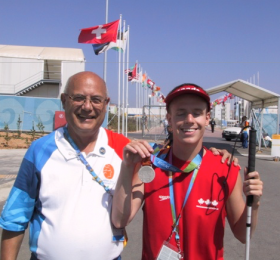 Campeche and San Cristobal de las Casas en Chiapas. Izamal is halfway between Valladolid and Merida. It used to be the road to Merida.
Campeche and San Cristobal de las Casas en Chiapas. Izamal is halfway between Valladolid and Merida. It used to be the road to Merida.
 Campeche and San Cristobal de las Casas en Chiapas. Izamal is halfway between Valladolid and Merida. It used to be the road to Merida.
Campeche and San Cristobal de las Casas en Chiapas. Izamal is halfway between Valladolid and Merida. It used to be the road to Merida. My plan was to visit them again and tour but I don’t know what I was looking for. I visited Valladolid first because that was the closest to Isla Mujeres. The third time I was here I tried the house I’m in and I said I could work with this. A family had grown up here. It had four bedrooms, and one floor. One of the daughters had taken it over and turned it into a rooming house, so there were padlocks on three of the other rooms that I couldn’t get into until I had been here three times. It hadn’t been maintained. It was a dump. But on the veranda, it had stone columns. That’s what actually sold me. I’m looking at one right now as I’m talking. I still find them a thing of beauty.
I bought the house at what I thought was a very reasonable price and now I understand that it was a gringo price. For the first year, there was no way I could live here. I was doing major, major construction and re-construction. Some days, I would have 25 people working here.
I knew I wanted a business but I had no idea what it was going to be. It was a good location on a little park, south of the main square, and I was going to put a palapa roof on the roof, like they do on the coast to catch the sea breezes. The first time I went up on the roof I said, “No, this does not need a palapa roof. This needs a second story.”
I’m certainly not an architect but because of industrial design and my other construction experience, I felt no qualms about designing the structure. I worked with the various masons to make sure that it was going to be strong enough, what I wanted to do, and how thick we should make things. It hasn’t fallen down yet and it changed the whole look and tone of the entire park area. I had a couple of scrubby plants mounted to the front yard and I started planting things that visually said “tropics.” Things like banana trees, coconut palm trees, bamboo; some trees that are tropical trees but don’t necessarily say tropics visually. I have some of those now, too.

Now I have a jungle as my front yard and a bridge running through the jungle to get to the house. I also put in a ramp in anticipation of someday possibly being in a walker, wheelchair, or something like that that has turned out to be a wonderful way to get water delivered in the garrafons and good for suitcases.
When I put in the second floor, I thought, “I have to figure out a way to help pay for this. Okay, I’ll open a bed and breakfast.” I had never done anything in the world of hospitality, so it was a matter of learning everything and I’m still learning. At this point for the third or fourth year we’ve got TripAdvisors’ Traveler’s Choice Award, which ranks us in the Top 25 bed and breakfasts in all of Mexico, and we’ve received a certificate of excellence from them for over nine years. So we’re successful at delivering the service I want to deliver. We’re still not making enough money to really support everything but I’m using a little money I had coming in from my pension plan annuity.
I’m using that to fund the lifestyle I could not even dream of having in the States. I have roughly a half an acre of ground that’s either jungle or structure. I have a building with the Valladolid English Library on the first floor and a language academy on the second floor, which I still run.
CB: Please tell us about your average day, Denis.
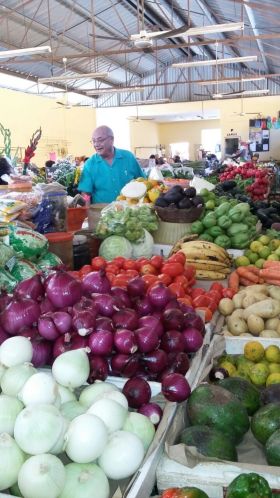 My normal day is I get up and do some hotel kind of work, checking on anybody checking out that day, coming in that day, and updating the system. I have a quick breakfast usually at my desk, and then go to the municipal market to shop for meat, vegetables, fruit, and spices and things like that. Then I go to the one of the small supermarkets to finish the shopping that I can’t get at the municipal market.
My normal day is I get up and do some hotel kind of work, checking on anybody checking out that day, coming in that day, and updating the system. I have a quick breakfast usually at my desk, and then go to the municipal market to shop for meat, vegetables, fruit, and spices and things like that. Then I go to the one of the small supermarkets to finish the shopping that I can’t get at the municipal market. Also, I do “dispensas” now.
CB: You do “dispensas?” What does that mean?
Denis Larsen: They’re very common here around Christmas time. All the supermarkets sell their own dispensas of a box of maybe a week’s worth of food and household essentials. Sometimes there are two or three days’ worth. We put together what amounts to two weeks’ worth of food and household essentials. It varies according to the price of the currency fluctuation, but usually around US $50 worth. They get beans and rice and some pasta and sometimes sardines, sugar, salt, soap, detergent, toothpaste, a toothbrush, vegetable oil, and cooking oil.
We used to do this in Northern Mexico too when we did some volunteer work up there. The living situation of the people we donated to there was such that they did not have fresh fruits and vegetables, so we gave a lot of that away. Here we don’t do that. Most of the people are growing oranges or bananas here and maybe even have some chickens, so they don’t need fresh fruit as much as they need things that they have to spend money to get. They don’t have money.
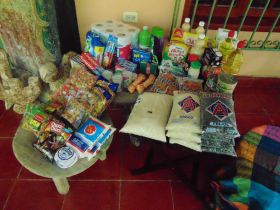
I try to save donations of money until I have enough. We go to this small, very local supermarket. The person with me has a calculator and we figure out our peso number that we could afford to spend on one dispensa and fill up the cart until we get to our magic number and we take the cart to the manager of the store and say we need eight of these or ten of these.
CB: Please tell us about some of your experiences with dispensas.
Denis Larsen: When my daughter comes down to visit once a year, she brings the money she raised in the States so we can get 25 or 30 of them. Within a few hours the manager delivers them here to the casa. My staff who either live in or have family in a number of small villages in Valladolid will ask the villagers, “We need five or six people in your village who need help; can you find them?” There’s never been a problem.
We fill our car with as many dispensas as we can and deliver them. We almost always have to take a Mayan speaker with us because many of the families don’t speak a lot of Spanish, particularly the old people. They never had to learn Spanish. For the women particularly, they have no need. The men, depending on what kind of work they did, might have to learn “construction Spanish,” but their Spanish, in many cases, is worse than mine.
When a guest to the B & B gives money for a dispensa, if we can work it out, we take them with us so they can present the box and if they want to say something they can. We always take their picture with the family and sometimes the family says just a brief thank you and sometimes it’s almost a poetic thanks.
I often think about how it is that people who are close to illiterate, who don’t know anything about the outside world, could be so well-spoken, so poetic and emotional. It’s really quite something. When 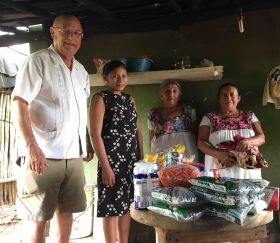 families who donated speak some Spanish and if the family receiving the dispensa speaks Spanish also, the family receiving the dispensa will want to show those donating everything in the house. They want to give them a whole tour of the house; the yard, the chickens, the goats if they have them, or whatever it might be.
families who donated speak some Spanish and if the family receiving the dispensa speaks Spanish also, the family receiving the dispensa will want to show those donating everything in the house. They want to give them a whole tour of the house; the yard, the chickens, the goats if they have them, or whatever it might be.
 families who donated speak some Spanish and if the family receiving the dispensa speaks Spanish also, the family receiving the dispensa will want to show those donating everything in the house. They want to give them a whole tour of the house; the yard, the chickens, the goats if they have them, or whatever it might be.
families who donated speak some Spanish and if the family receiving the dispensa speaks Spanish also, the family receiving the dispensa will want to show those donating everything in the house. They want to give them a whole tour of the house; the yard, the chickens, the goats if they have them, or whatever it might be. We had a family from Southern California—a husband, wife, and three adult daughters—all of them spoke very good Spanish, so the family receiving the dispensa just loved them. The family receiving the dispensa showed them around and finally asked, “Can we cook lunch for you? Would you like something to eat?” They said no.
One of the adult daughters had nail polish in her purse so she did the nails of five of the kids in the house and they were just so-, I wish I could do the visual here. They got their fingers up and they were just so proud of their nail polish, and so I told my daughter the next time she brings stuff down for a dispensa to include some nail polish because it’s inexpensive and it’s a treat that many of the kids and mothers just can’t afford.
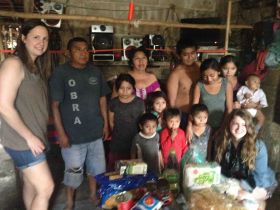



.png)